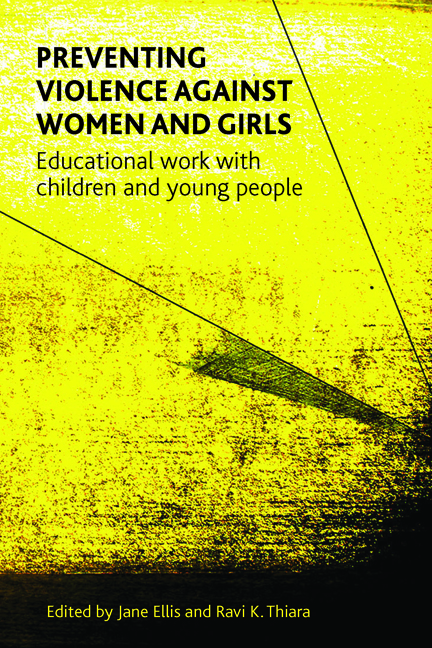Book contents
- Frontmatter
- Dedication
- Contents
- List of tables and figures
- Notes on contributors
- Acknowledgements
- Foreword
- Introduction
- one Preventing violence against women and girls through education: dilemmas and challenges
- two Does gender matter in violence prevention programmes?
- three Responding to sexual violence in girls’ intimate relationships: the role of schools
- four ‘Pandora’s Box’: preventing violence against black and minority ethnic women and girls
- five Preventing violence against women and girls: a whole school approach
- six What did you learn at school today? Education for prevention
- seven No silent witnesses: strategies in schools to empower and support disclosure
- eight Preventing sexual violence: the role of the voluntary sector
- nine ‘Boys think girls are toys’: sexual exploitation and young people
- ten MsUnderstood: the benefits of engaging young women in antiviolence work
- eleven Shifting Boundaries: lessons on relationships for students in middle school
- Concluding remarks
- Appendix: Examples of programmes in the UK
- Index
Concluding remarks
Published online by Cambridge University Press: 04 March 2022
- Frontmatter
- Dedication
- Contents
- List of tables and figures
- Notes on contributors
- Acknowledgements
- Foreword
- Introduction
- one Preventing violence against women and girls through education: dilemmas and challenges
- two Does gender matter in violence prevention programmes?
- three Responding to sexual violence in girls’ intimate relationships: the role of schools
- four ‘Pandora’s Box’: preventing violence against black and minority ethnic women and girls
- five Preventing violence against women and girls: a whole school approach
- six What did you learn at school today? Education for prevention
- seven No silent witnesses: strategies in schools to empower and support disclosure
- eight Preventing sexual violence: the role of the voluntary sector
- nine ‘Boys think girls are toys’: sexual exploitation and young people
- ten MsUnderstood: the benefits of engaging young women in antiviolence work
- eleven Shifting Boundaries: lessons on relationships for students in middle school
- Concluding remarks
- Appendix: Examples of programmes in the UK
- Index
Summary
As this collection has demonstrated, prevention work with young people through education has gained increased interest and currency amongst those seeking to prevent VAWG in both the short and long term. Starting with calls to develop educational work in the 1980s, a recognition of the harm caused by domestic violence and child sexual abuse to children and young people, as well as violence in their own intimate relationships, has led to intensified demands for prevention work. There is no doubt that practice has preceded policy in this area and despite the ongoing absence of a clear policy mandate, certainly in England, practitioners continue to carve out spaces for prevention work with children and young people in school and non-school settings. The motivations for this work inevitably differ and clearly shape both the kind of programmes that are developed and the ways in which they are implemented. Despite this variation, some commonalities are evident, including: a commitment to fostering healthy relationships and behaviours among young people; challenging violence and the harm it causes to not only women but also to children; engendering in children and young people the skills to resolve conflict through non-violent means; and building their confidence to seek help by equipping them with knowledge and information. Since schools provide access to almost all children and young people, they have been considered an important site for prevention work on VAWG. However, as noted by Crooks et al (2008), ‘effective programs have achieved neither widespread nor sustained implementation’ in schools’ (p 111). Clearly the reasons for this are many, as discussed in the foregoing chapters in this volume. However, there is some learning from the prevention work that has been developed that needs to be borne in mind by anyone seeking to develop prevention work with young people.
As can be seen by the diverse prevention programmes that have been developed in the UK and elsewhere, a range of issues and dilemmas have been encountered. Together, the contributors’ work highlights some key lessons for those embarking on their journeys. It is clearly evident that the ideological, conceptual and moral arguments underlying prevention work are complex and perhaps unresolvable. However, there is broad consensus about the need to carry out this work even if the motivations for it continue to differ.
- Type
- Chapter
- Information
- Preventing Violence against Women and GirlsEducational Work with Children and Young People, pp. 247 - 254Publisher: Bristol University PressPrint publication year: 2014



